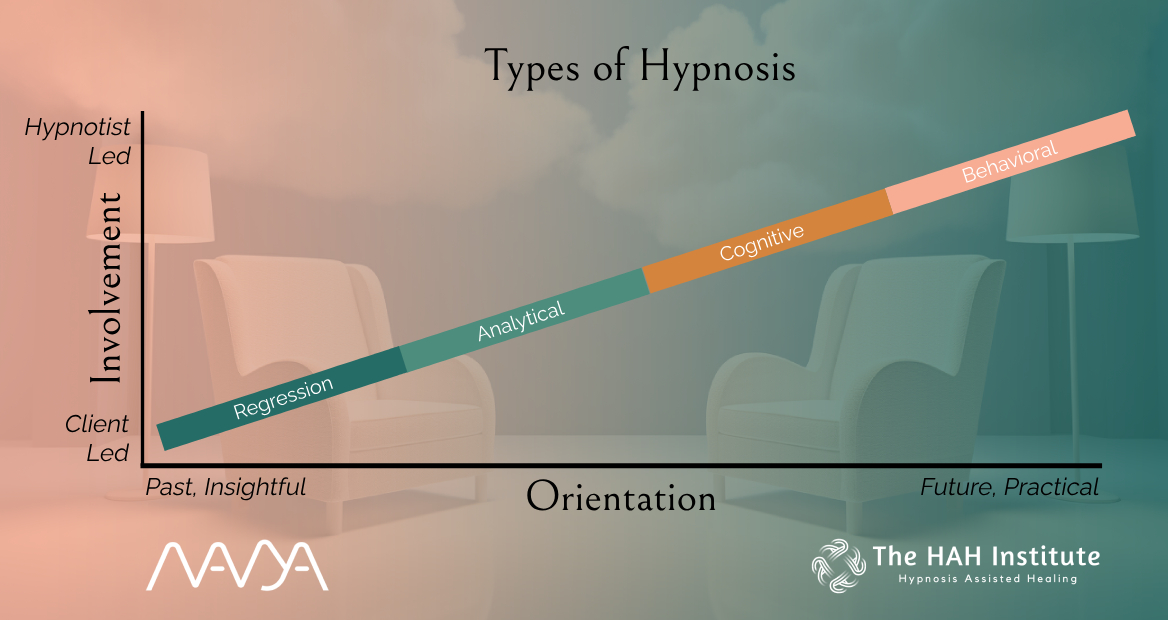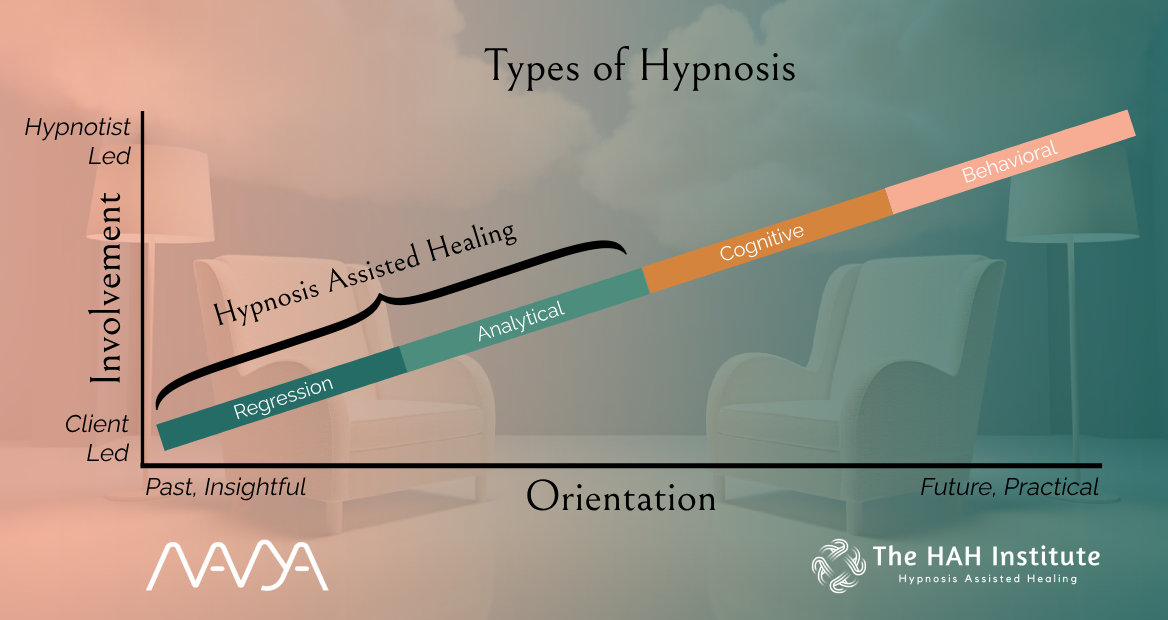Similar to how “therapy” is actually a very broad term to many different treatment modalities, “hypnosis” also contains many different modalities and approaches within it.
When searching for a therapist, there are many factors to keep in mind, the most important being chemistry with your therapist. This connection with your therapist is one of the biggest predictors of success of your therapy.
Another key factor to consider is the type of therapy you’ll be doing. Different therapy approaches appeal to different people, at different stages of their lives, when dealing with different problems or issues. Most therapists train in a variety of techniques, and they’ll often make the judgement call of which technique to use when.
But overall, you might often find themselves grouping into categories – those who prefer more empirically based treatments might gravitate towards CBT and DBT, while those preferring more holistic or analytical approaches might include things like Gestalt or IFS, Internal Family Systems, which is very popular right now.
Understanding that there is a spectrum of techniques and approaches when seeking out a therapist is a key component of finding the hypnotist who is right for you. Most therapists understand this, and disucss their therapy modalities, influences, and philosophies openly on their websites or directory listings (like Psychology Today).
It’s important to note that these treatment modalities are not about what is being treatment, but rather how you go about treating it. CBT is applied to everything from depression to phobias, and you can look at almost every problem from a psychoanalytical lense, if you so choose. That said, certain modalities are better suited for certain issues, such as EMDR for Trauma or DBT for borderline personality disorder.
Different Types of Hypnotherapy
With this in mind, it can be helpful to understand that hypnosis also has different treatment modalities within it. Simply referring to “hypnosis” can still be fairly vague: just like “therapy” tell us in broad strokes that you’re meeting with a mental health professional but doesn’t really tell us what you’re doing in the session other than talking, “hypnosis” tells us that you’re probably sitting or lying with your eyes closed, but doesn’t tell us much more than that.
This can be a bit confusing, because hypnosis is also essentially a form of therapy (No intro to counseling theories can go without mentioning Milton Erikson’s hypnosis techniques). And yet, it is so broad that it has carved out a niche of its own, and has somehow avoided regulation by maintaining its own grey zone within which it lives.
So at this point you have both therapists and non-therapists practicing “hypnosis”, which actually contains within it an array of tools, techniques, and approaches which they often specialize in. And it’s often not clear exactly what they do and don’t do.
Confusing? You bet. Understanding these approaches can help you have informed conversations and make informed decisions when selecting a hypnotist, as well as further understanding the differences between hypnosis and therapy. It might start with a google search for “Hypnotist Near Me”, but as you sift through the different results, keep the insights you gain from this article in mind.
Broadly speaking, it can help to think of hypnosis approaches as falling in to four broad categories, and interestingly, these categories aften mirror different techniques and philosophies found within the world of therapy.
Behavioral Hypnosis
The first type of hypnosis is behavioral. It also one of the most common. Within this approach, the hypnotist aims to change certain behaviors in the client. Think of the classic hypnosis to stop smoking, or hypnosis for weight loss, hypnosis for nail biting, or hypnosis for insomnia. These are all examples of behavioral issues that people might want to change.
Typically, the hypnotist’s approach to these behavior changes would be to use “suggestions” to create change. While in a state of hypnosis you are more open to suggestion, your subconscious is better able to entertain the idea of things being different, in a very matter of fact sort of way. And since your subconscious, not your analytical mind, is actually at the root of much of your decisions and choices, the idea here is that if you can effortlessly shift the way your subconscious perceives certain behaviors, you’ll create effortless change.
Suggestions for behavioral change can be rather prescriptive – I can create a script with multiple suggestions in it, and read it to a variety of people, which each might benefit from some of the many suggestions it contains. As such, behavioral hypnosis is very common because it doesn’t require much training on the part of the hypnotist – they can basically have a range of scripts at their disposal, which they read to the right client at the right time.
Sometimes, when this type of hypnotist encounters a new problem they haven’t seen before, they simply spend a few days seeking out a new script, and then they are ready to see you.
This is the reason hypnosis so often focuses on behaviors – its easy to become a behavioral hypnotist, the changes you create are measurable (did you stop smoking? did you manage to get on that airplane?), and it doesn’t really resemble therapy. When it works, it can be surprising and effortless, people might not realize they aren’t drinking alcohol anymore, for example, until they reflect back and realize they’ve changed without even noticing it.
Cognitive Hypnosis
The next form of hypnosis is cognitive hypnosis. This approach aims to change the way you think about things. Things like hypnosis for self esteem, hypnosis for body image, hypnosis for anxiety, these are the types of things that cognitive hypnosis might address (although most hypnotists will avoid using terms like “anxiety” because they are not licensed to treat mental health issues, and they’ll use terms like “fears” instead).
With this form of hypnosis, the hypnotist might help the client identify the current thoughts they have, which are causing them issues in their life, but then the main focus is on creating new, more helpful thought patterns.
Thinking “I can do this” instead of “this is impossible”, “I can remember things clearly whenever I wish” instead of “I am a forgetful and absent-minded person”, or “I am loveable and attractive” instead of “I am ugly and nobody likes me” are all examples of creating more helpful and supportive thought patterns.
In many ways this can resemble affirmations, which we are often encouraged to create for ourselves, and which are often also a part of cognitive therapy. Within cognitive hypnosis, these affirmations are essentially repeated specifically while in a state of hypnosis, when you are more suggestible and the insights can impact more deeply.
Here too, you might notice that the solutions can be rather prescriptive. A hypnotist can use scripts, or a generally similar approach for almost anyone who comes to me with a specific issue.
No matter how many people come to a hypnotist with self esteem issues, and regardless of what the root of those issues are, they all might benefit from the same variations of positive cognitive shifts. So with just a few of these scripts or suggestions in their back pocket, a relatively untrained hypnotist can still work with many people in this way.
You might notice that Behavioral Hypnosis and Cognitive Hypnosis have certain parallels to Cognitive Behavior Therapy. Both specifically target cognitions and behaviors. Both are popular, because they are easy to train in and easy to measure results with. They can be prescriptively applied to a wide range of situations. And they both aim to create future-oriented change in your thoughts and behaviors without diving into the why of how you ended up this way in the first place.
Analytical Hypnosis
Next compes analytical hypnosis. Analytical hypnosis aims to help clients understand what is happening and why it is happening, with the assumption that this understanding will lead to change.
This mirrors the perspective of classing psychodynamic therapy theories, that center around understanding the impact your past is having on your present. The impact certain pivotal experiences and memories had on you, the impact of the type of childhood you had, and the types of people your parents were. The stereotypical therapist asking you to “tell me about your mother.”
Analytical hypnosis takes this same approach, while the client is in a state of trance. Analysis while in trance can lead to deeper insights faster, and often to a more emotional reaction to those insights, as the cognitive or rational part of the brain is bypassed while in hypnosis. This means that its easier for your mind to make the less obvious, but still very significant, associations and connections it needs to give you clarity on an issue.
As you can imagine, analytical hypnosis requires more mastery on the part of the hypnotist. They cannot simply prescribe certain things, everything is an open question and they must think on the spot about what the next qeustion or step might be depending on what the client shares.
Whereas there might be a few “tried and true”, highly effectively cognitive and behavioral hypnosis suggestions that they can use time and time again, there is an infinite number of insights and experiences that a client can share from their own lives and inner world, and it takes more skill on the part of the hypnotist to navigate this in real time. This is why there are far fewer hypnotists who practice this form of hypnosis.
Critics of analytical hypnosis would say it’s simply not necessary. You don’t need to focus on why when hypnosis offers such powerful tools to create future-oriented change regardless of the reason. Others might find that cognitive hypnosis or behavioral hypnosis doesn’t work as well for them as analytical hypnosis, or might specifically want an analytical component to their personal growth.
People’s preferences for their form of hypnosis might mirror their preferences in therapy – if you gravitate towards wanting to better understand your past and internal workings as part of creating change through therapy, you might find analytical hypnosis compliments and enhances this process for you.
There are a few more guiding questions at the end of this article to help you make a more informed decision as to which approach might be better for you.
Regression Hypnosis
The final type of hypnosis is regression hypnosis. WIth this approach, not only do you analyze your internal emotional world to understand yourself and your behaviors better, but you actually “regress” and go back in time to explore specific experiences that may have impacted you.
Although hypnotists can sometimes regress you to a specific memory or time in your life to help you tap into the positive associations and feelings you have there, for our purposes when discussing regression hypnosis, we’re referring to a more systemic approach where you regress to typically unpleasant memories in order to re-frame and heal them.
While in a state of trance, your imagination and sensitivity is enhanced, and you can easily and vividly re-create a past memory while still feeling safe and secure. The negative emotions from the experience can be released, and new alternatives to the memory can be created – your subconscious cannot differentiate between actual past and a vividly imagined alternative.
This is often accompanied by a deep sense of having made sense of something; a certain closure, wholeness, or completeness often accompanies this process as the client returns to the present moment with a sense of having addressed their “unfinished business.”
When people first thing of regression hypnosis, there is often an association with past life regression, of traveling back to a different lifetime to explore and find insight there. It’s worth noting that any travel back in time is a form of regression, and the vast majority of the Hypnosis Assisted Healing sessions we do at Navya involve regression to earlier memories from the current lifetime.
Furthermore, it’s worth noting briefly that there are two main ways of thinking about past life regression (PLR) – either as a revisiting of actual past lives due to the presence of a soul or a similar spiritual context, or a sense-making experience created by our mind to understand our past in a more abstract way, similar to a dream. Discussing this further is a topic for another article.
Safely navigating past painful memories in a way that is healing and safe requires the most skill on behalf of the hypnotist, and is therefore the most rare form of hypnosis. Regression hypnosis is at least briefly taught as part of many hypnosis trainings, but in practice, most hypnotists stay away from it.
DIY or DFY: A Spectrum of Involvement
With anything to do with hypnosis, there is a spectrum of involvement that the hypnotist has on the client.
On one hand, all hypnosis involves a certain amount of instructions or “suggestions” on behalf of the hypnotist – this is how they put you into a hypnotic trance in the first place. On the other hand, it is a commonly agreed upon principle that “all hypnosis is self-hypnosis” meaning that these suggestions must pass through the filter of the client’s own brain, and then the mind chooses whether to implement them or not. You can imagine a the subsocnsou sort of sitting there, expectantly, and analyzing each suggestion as to whether it “resonates” with it or not. If it does, it follows it happily. if it doesn’t, it effortlessly ignores it.
When it comes to Behavioral or Cognitive hypnosis, the hypnotist often takes a more proactive approach. They are the ones who do most of the talking, as they proactively make these suggestions to the client while the lcient is in trance. Since it’s all about creating future-oriented change, and since seemingly the client is “stuck” in an unproductive way of thinking and acting, it is up to the hypnotist to suggest new ways of being that they might not have even thought of or realized were possible. This is the power of hypnosis.
The graph below helps illustrate the four types of hypnosis – how they proceed both in their orientation from past and insightful to future and practical, to the involvement of the hypnotist, starting with a more client-led approach and progressing to one where the hypnotist leads more ofe the session.
When it comes to analytical and regression hypnosis, the script must flip. It is up to the client to do a lot of the work. The hypnotist does not know what is going on in their mind. They can provide suggestions, but they need to get continous feedback about what insights are emerging, what is working and what isn’t.
Here, providing too much instructions or suggestions can have a negative impact – especially when it comes to regression, making any sort of suggestion as to what the client is seeing or feeling can create false memories and leave the hypnotist’s “fingerprints” on the experience.
It’s almost like the hypnotist must switch gears – from assuming a more direct approach when putting a client into trance or guiding them to better thoughts and behaviors, to becoming a more passive, inquisitive, and supportive role when the client is an analytical or regressive state. This is what a lot of hypnotists get wrong: they maintain their same directive-oriented approach in all situations; and this has resulted in a lot of the criticisms and cautions that are currently levied against regression hypnosis in particular.
The Hypnosis Assisted Healing Approach
Hypnosis Assisted Healing lies firmly at a certain part of this spectrum. It focuses primarily on Analysis and Regression forms of hypnosis, and takes a hands-off approach where the client is supported in creating much of the experience for themselves. Our philosophy is that being masters of your own healing can be a profoundly empowering experience, where you actually find your own answers as part of your journey.
This sets it apart from therapy as well – just as we do not offer direct suggestions as to what to feel or think, as some hypnotists might, we also don’t offer our own analysis about what’s happening. It’s always up to you to make sense of things.
If we were to examine the graph above, here is where Hypnosis Assisted Healing would fall on the spectrum:
(It’s worth noting that sometimes it can be helpful and important to have a skilled therapist point things out – providing insights that you might be blind to, or a framework of understanding things from the lenses of different modalities. Working with a therapist can also help you establish gian interpersonal skills and learn to trust others. At Navya, this is not our primary focus: our goal is to encourage deeper intrapersonal insight and skills, helping you develop a deeper connection to yourself. We encourage all our clients to also seek conventional therapy in conjunction with any Hypnosis work they engage in.)
So there you have it. Four approaches, each with their own application and flavor, each suitable for different people and issues. They run on a spectrum from future-oriented and practical to insightful and introspective. And on top of that you must factor in how involved you want your hypnotist to be. Hopefully this article gives you much to ponder about as you go about selecting the right hypnosis modality for your needs. Below are a few more questions that can help clarify things further.
What type of hypnosis is right for you?
There is no right answer, just points to ponder. These questions can help you gain clarity as to what kind of hypnosis approach fits your needs.
- Do you want to solve the issue as quickly as possible, or do you the time, resources, and interest to understand it more deeply first?
- If you could, would you rather someone waved a magic wand and solved your issue, or would you prefer to feel like it was your own process that solved the issue?
- Do you find yourself going through life in a more cerebral, logical way, or are you more guided by your heart and emotions?
- Do you prefer big picture thinking, or do you prefer more practical, detail-oriented thinking.
- Do you feel like this issue is something that presented more recently in your life, or do you feel like it’s something that’s deeply rooted in your past?
- Do you feel ready or interested to explore your past, or is it something you are not interested in or dont’ feel the time is right for?





